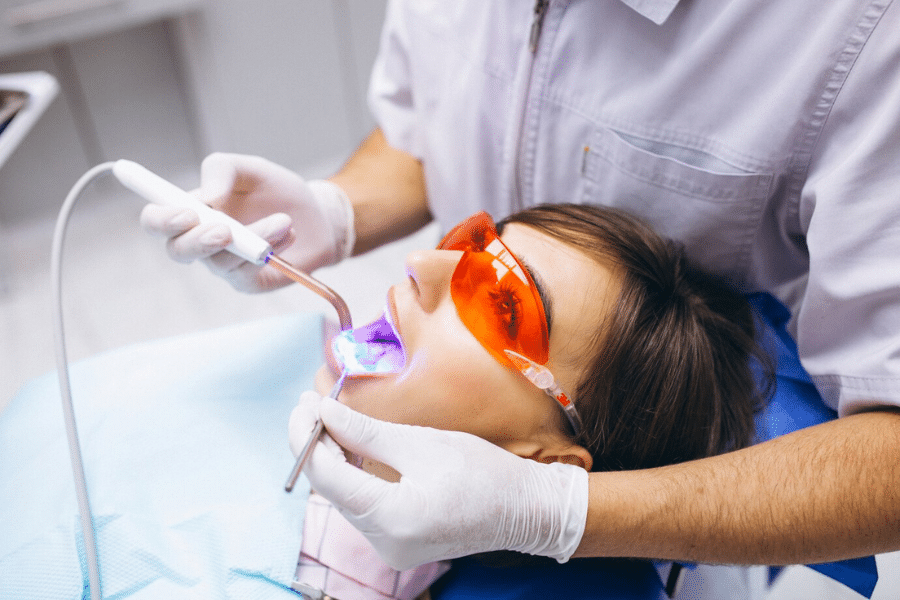Over the years, advancements continue to reshape traditional practices. This has resulted in providing patients with safer, more efficient, and less invasive treatment options. One such innovation that has gained momentum in recent years is laser dentistry, particularly in the realm of gum therapy. Gone are the days of uncomfortable procedures and prolonged recovery times. Laser Dentistry offers a modern solution to address various gum-related issues with precision and care. Let us delve into the role of laser dentistry in gum therapy and how it is revolutionizing dental care.
Understanding Gum Therapy
Before delving into the specifics of laser dentistry’s role in gum therapy, it is crucial to understand the importance of gum health. The gums, also known as gingiva, play a vital role in supporting and protecting our teeth. However, various factors such as poor oral hygiene, genetics, hormonal changes, and certain medical conditions can lead to gum disease, commonly known as periodontal disease.
Periodontal disease encompasses a range of conditions, from gingivitis, characterized by inflammation and bleeding gums, to advanced periodontitis. This can result in tooth loss and even impact overall health. Traditional treatment methods for gum disease often involve scaling and root planing. It requires the use of manual instruments to remove plaque and tartar buildup from below the gum line. While effective, these procedures can be uncomfortable and may require multiple visits to achieve desired results.
Enter Laser Dentistry
Laser dentistry offers a minimally invasive alternative to traditional gum therapy methods. By harnessing the power of concentrated light energy, dental professionals can precisely target and treat gum disease while minimizing discomfort and promoting faster healing. The laser acts as a precise tool, selectively removing diseased tissue and bacteria while leaving healthy tissue unharmed.
Also referred to as low-level laser therapy (LLLT), therapeutic laser treatment offers a myriad of benefits. Some of it includes promoting tissue healing and reducing gum inflammation and pain (Sun & Tunér, 2004). One of the key benefits of laser dentistry in gum therapy is its ability to achieve superior results with minimal trauma to surrounding tissues. Unlike traditional methods, lasers cauterize as they work, reducing bleeding and the risk of infection. This not only enhances patient comfort during the procedure but also accelerates the healing process, allowing for quicker recovery times.
Applications of Laser Dentistry in Gum Therapy
Over the last decade, various dental laser wavelengths, most commonly diode lasers, have been used by clinicians in the treatment of periodontitis. In addition, photodynamic therapy protocols use diode lasers with wavelengths in the range of 635 nm to 690 nm combined with a photosensitizer to eradicate subgingival microbes (Cobb et al., 2010).
Laser dentistry can be utilized in various aspects of gum therapy. One such aspect is periodontal pocket reduction. With the help of laser therapy, dentists effectively target and eliminate bacteria residing in periodontal pockets. It results in reducing pocket depth and eventually promotes gum tissue regeneration.
Also, laser technology allows for precise reshaping of gum tissue to improve aesthetics and address issues such as a “gummy” smile. From gingivitis to advanced periodontitis, lasers offer a versatile approach to treating gum disease with minimal discomfort and faster recovery. In cases where teeth are partially covered by excess gum tissue, lasers can be used to reshape the gums, exposing more of the tooth’s surface.

Non-Surgical Approaches to Periodontal Treatment
When it comes to dealing with gum problems, getting a deep clean called subgingival scaling and root planing (SRP) is still the best way to go. However, here is the catch: This method involves digging into your gums, which can make things worse before they get better. How well your gums heal afterward really depends on how your body reacts on a cellular level. To boost the results of non-surgical gum treatment, some dentists are using powerful lasers like Er: YAG, Nd: YAG, or diode lasers. These lasers help remove tartar, clean out pockets, and kill bacteria, making the treatment more effective (Ren et al., 2017).
References
Sun, G., & Tunér, J. (2004). Low-level laser therapy in dentistry. Dental Clinics, 48(4), 1061-1076.
Cobb, C. M., Low, S. B., & Coluzzi, D. J. (2010). Lasers and the treatment of chronic periodontitis. Dental Clinics, 54(1), 35-53.
Ren, C., McGrath, C., Jin, L., Zhang, C., & Yang, Y. (2017). The effectiveness of low‐level laser therapy as an adjunct to non‐surgical periodontal treatment: a meta‐analysis. Journal of Periodontal Research, 52(1), 8-20.



